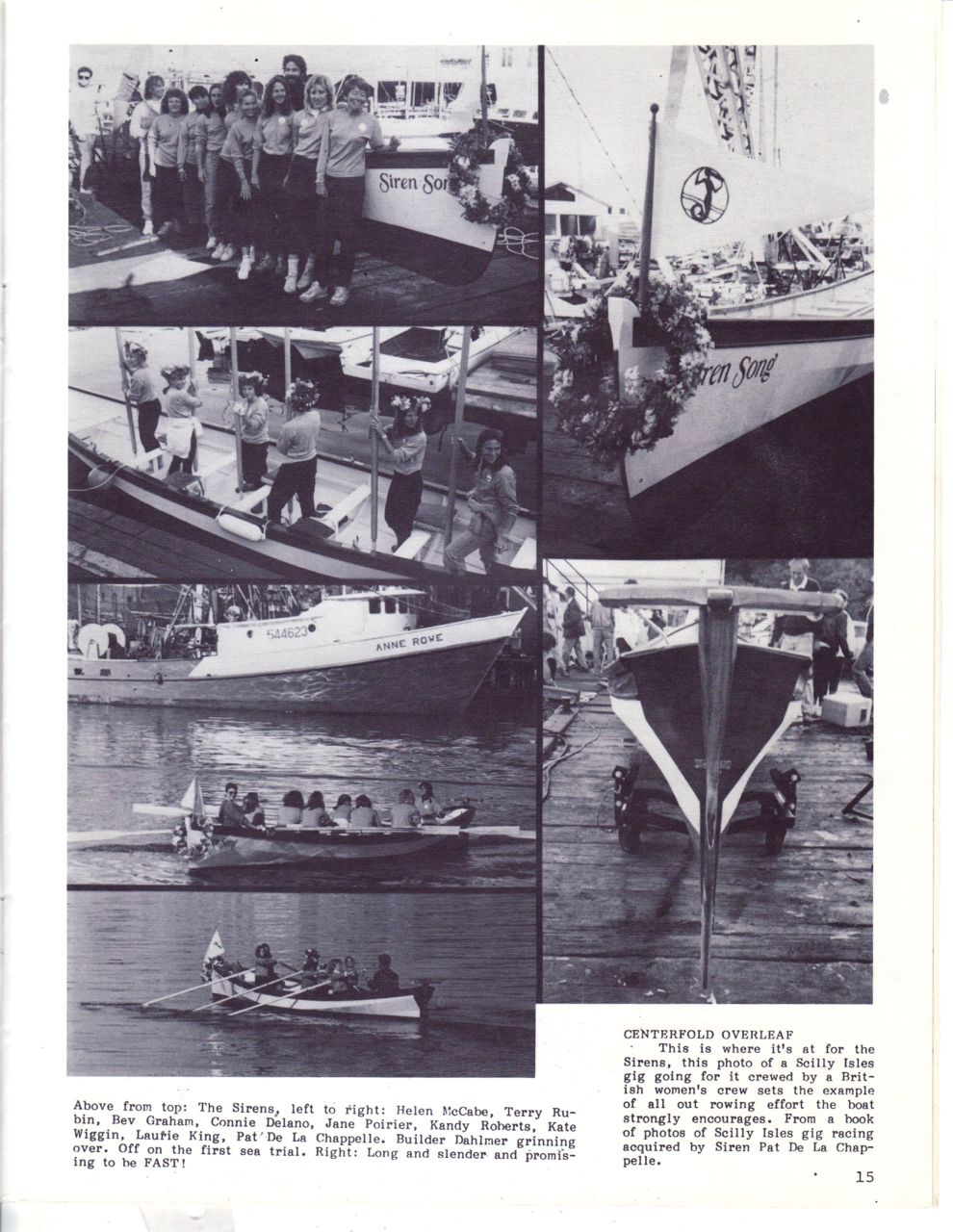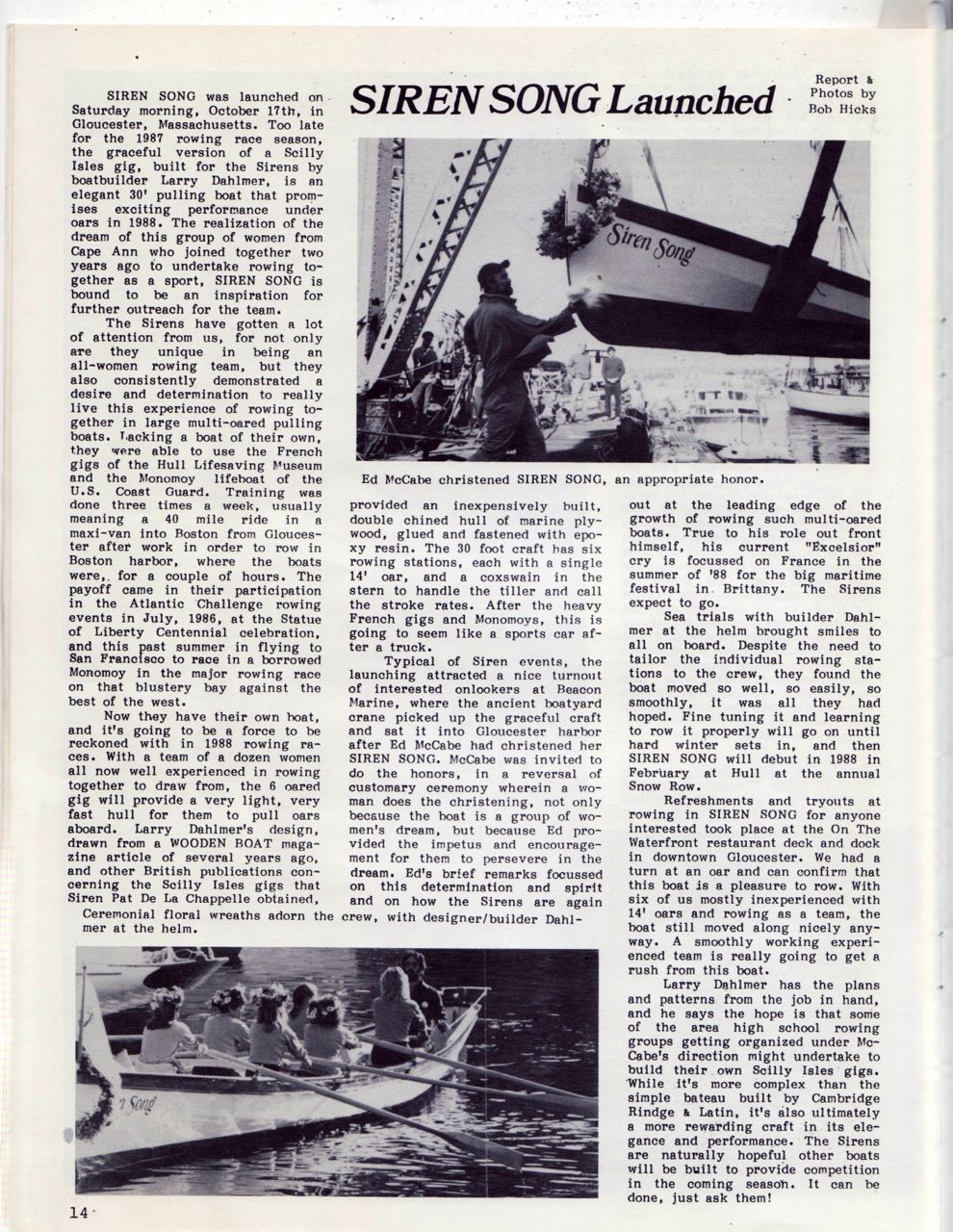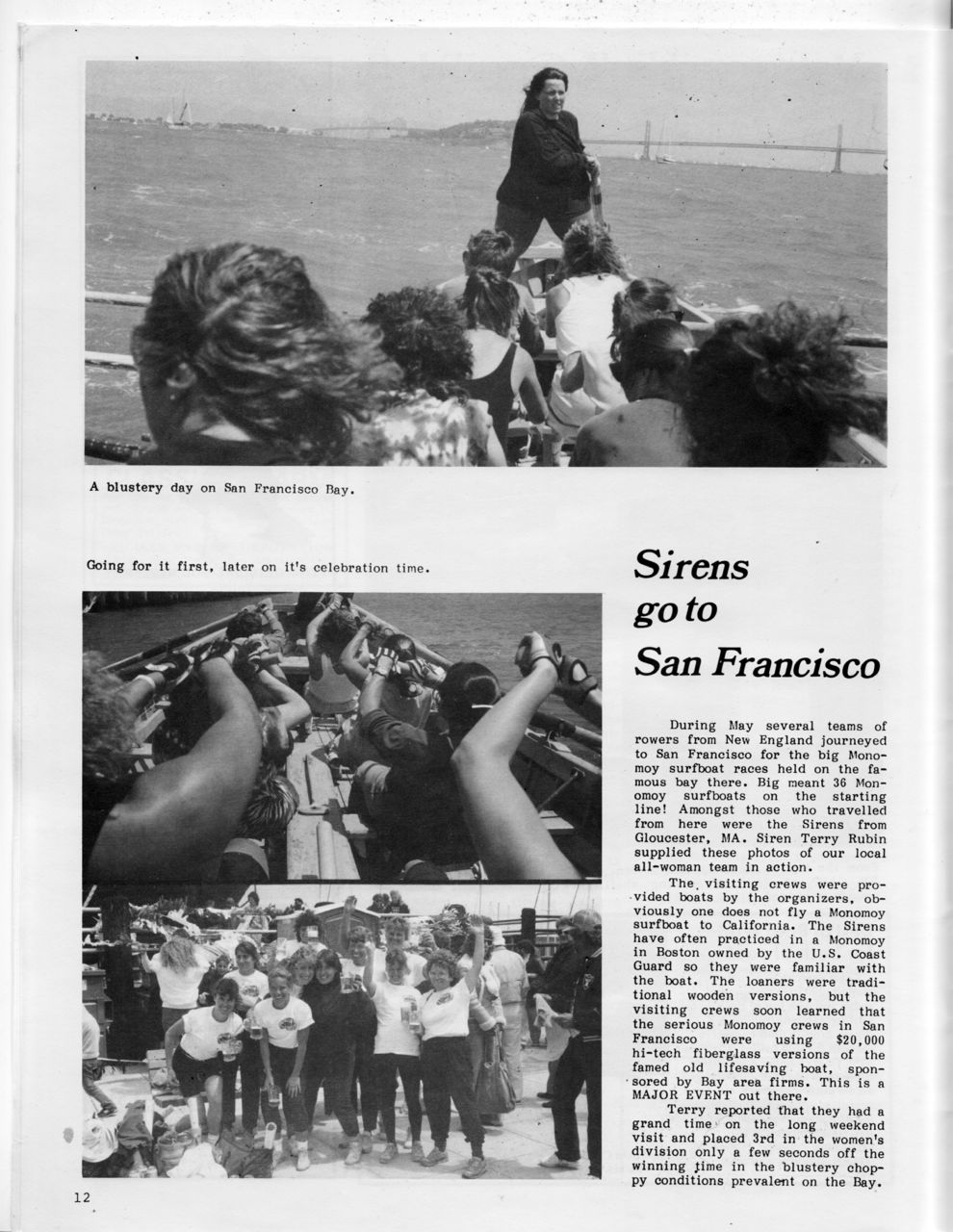This is the story, as told by Ann Banks, of a small group of women who came together in Gloucester to row competitively, acquired the Siren Song boat, and rowed in the Atlantic Challenge at the rededication of the Statute of Liberty, at the 50th celebration of the Golden Gate Bridge, and in Doaurnenez in Brittany, France. We can consider them the original Gloucester Gig Rowers.

There are probably as many stories as there were people involved in this original endeavor. This is just what I could put together. Laurie Fleming’s archive of memories and newspaper clippings has helped me fill the gaps in my story.
A beginning
In the late 1970s there were a few Cornell alumnae living on Cape Ann. One of them was a sorority sister of mine: Pat de la Chapelle, who lived with her husband Dick in Rockport. I knew Pat as a determined competitor and organizer, and she became the senior member of the group who to me epitomized its drive. Let’s start the story, then, with her, in 1985.
Pat volunteered to tend the library at the newly formed Ocean Research and Education Society (ORES) on Harbor Loop in Gloucester. It sought to attract college age students to sea and marine research. They had a tall ship, the Regina Maris, on which students went to sea for training and research. Pat became interested in traditional local boats, the dories, and actually rowing them, and so she connected with the Gloucester Museum School’s Project Adventure Summer Camp. She and some other young women began to row their dories on a regular basis.
The Statue of Liberty and the Atlantic Challenge
In 1986 a refurbished Statue of Liberty was to be rededicated in a big celebration over the fourth of July. The celebration would happen on the weekend of July 3, 4, and 5.
[There would be a] 100-ship parade in the East River, a 100-piece orchestra and 300 voice choir. The American Music Concert including John Denver, Johnny Cash, Barry Manilow, Whitney Houston and others and the 400-shell firework display fired from 42 barges anchored around the statue.
– Daily Evening Item, Lynn, Mass., Thursday, June 26, 1986
Lance Lee of Rockport, Maine and Frenchman Bernard Cadoret conceived of a rowing contest, in Bantry Bay gigs, for the celebration. The series of challenges, modeled after French Maritime School requirements, included a man overboard drill, a tug-a-war, a lashed rudder race, a slalom course, a sprint, and knot-tying. It was to be known as The Atlantic Challenge. (This challenge has persisted and grown to become the Atlantic Challenge International, now occurring every other year, with over twelve different countries, in Bantry Bay gigs.)
Boat building
Lee was an inveterate boat builder, founder of the Rockport Apprentice Shop in Maine, and had taken the lines off (made detailed measurements of) a gig in the National Maritime Museum in Dun Laoghaire, near Dublin, Ireland. This gig was a Frenchman’s barge, captured, or maybe just left behind, from a French Man O’War in the attempted invasion of the west coast in 1796. It was known as a Bantry Bay Gig for the bay in which it was found.
In Hull, Massachusetts, Ed McCabe, Director of the Hull Lifesaving Museum, had been approached by some high school students who thought they should be learning about building boats and rowing. Ed took over an old boathouse down by the High School and started a program.
[The students started] to compete in some New England races, and when the Statue of Liberty celebration came about, McCabe approached Lee with the idea of building (a Bantry Bay gig christened) Liberté for the competition”.
– Daily Evening Item, Lynn, Mass.,Thursday, June 26, 1986
Lee built two Bantry Bays Gigs for the competition: the Liberté and Egalité. McCabe berthed the Liberté in Hull. I don’t know where the Egalité went. Both boats were used in the July competition. A third boat, the Fraternité, was built in France, undoubtably used by the team in Brest.
A women’s crew comes together for the Challenge
Jim Schoel heard about the Atlantic Challenge. He and Lance Lee had been Outward Bound instructors together on Hurricaine Island. In January, 1985, Jim mentioned it to the women rowing the dories at Project Adventure Summer Camp. He felt there was a place for a women’s team in the upcoming competition.
Pat de la Chapelle, (my friend) a member of the museum school’s boat committee, Kandy Roberts, co-manager of Sailor Stan’s Restaurant, Bev Graham of Graham Electronics, and Laurie King [now Fleming], whose husband is a gill-netter, were the first to respond strongly to the suggestion. When these four women began to look for other rowers , they found themselves at the center of a storm of interest. Women just poured in to their first organizational meeting at Sailor Stan’s (the Roberts sisters’ restaurant on Rocky Neck).
–Rowing for the glory, Kasha Gula: Gloucester Daily Times, Wednesday, March 19, 1986
Ed McCabe came to Gloucester to this initial meeting at Sailor Stan’s.
[He’d heard that there was a] co-ed French team looking for American teams to challenge. A group of male rowers in Hull, who were planning to compete, needed some female rowers to round out their team. They thought Gloucester might be a good place to find them because of the city’s long tradition of dory rowing.
– North Shore Weeklies, March 13, 1991
Twelve women started to train for the event: Pat de la Chapelle, Laurie Fleming, Kandy Roberts, Bev Graham, Lila Frederick, Helen McCabe, Susan Price, Carly Johnson, Linda Hart, Jo-Anne Finckle, Kate Wiggin, and Christine Burak. At least two more women were added as alternates, maybe more, as they were fourteen at the event in New York. They referred to themselves as The Sirens. The Sirens of Greek mythology were beautiful female figures who sat on the rocks and lured passing sailors to their deaths in shipwrecks with their music and song.
Perhaps the most interesting element of this competition is the quality of the women. They are not professional athletes or recent college graduates who have just spent four years on a varsity team. Burak, a real estate agent in Manchester, said the professions range from landscaper to restaurant manager to marine electronics worker. The ages range from mid-20s to early 50s. Some are married with children, some are not.
– Daily Evening Item, Dale Seamans, Lynn, Mass. Thursday, June 26
The women trained at least twice a week in a Monomoy at the Coast Guard Station at Constitution Park in Boston and in the Bantry Bay Gig, the Liberté, in Hull. They were the only boats available for the team to train in.
Aside from learning how to row the boats, the women had to learn man overboard drills, how to run a slalom course, and how to tie a variety of knots. They also had to commit to a six-day-a-week workout program including rowing, weights and running.
– Sirens row to international renown, North Shore Weeklies , March 13, 1991A rigorous training schedule whittled the numbers down
– The Region, week of August 12, 1987
A Bantry Bay Gig is not an easy boat to row. Ocean rowing is different from rowing a river in a shell.
[The boats] are really heavy, Jane MacDonald says. They take 10 people to row, plus a coxswain. Rowers sit one by one staggered on opposite sides, each with an oar that goes across the boat to reach the water on the other side.
– North Shore Weeklies, week of August 12, 1987
Raising funds: rock & roll, and a very long row
The Sirens figured that their expenses could run as high as $6,000 for the event. Fund-raising was needed. Jim Schoel offered the non-profit status of the Gloucester Museum School as a repository. First, two rock ’n roll dances at the (then) St. Peter’s Club were planned; one on Friday, March 21 and one on Friday, April 4.
The Walker Creek Band would play with a good roster of classic rock ’n roll and rhythm and blues hits.
– Ladler….newspaper article
The most memorable fund raising event was a 25 mile row from Boston Harbor to Gloucester in the Liberté.
Undaunted by gusty head winds and three to five foot swells, the Gloucester Women’s rowing team – the Sirens – went ahead with the 25-mile Boston to Gloucester Row. On June 7, (1986) at 7:30 AM, the 13 member crew pushed off from Boston’s North End Coast Guard Station […] Donald King motored within sight of the crew in his gill-netter, the Marion I. An hour into the row, the drizzle turned to steady rain. Despite the rain and the 50-degree temperature […] the women continued to pull the heavy mahogany oars through the white capped seas. Most of the rowers were clad only in red cotton T-shirts, tights and sneakers.
Over the rhythmic click of ten oars churning, they sang sea chanties and told dirty jokes to pass the time, said (Bev) Graham (on the tiller).
Every hour they rotated positions and had a few minutes to refuel on bananas and chocolate before beginning another hour of rowing. Because they had three extra rowers on board, the crew took turns sitting out.
When the Liberté was off Nahant, the weather took another turn for the worse…the tide changed.
Just past Half-Way Rock, only 61/2 miles from the mouth of Gloucester Harbor, the Marion motored alongside … and King told them that at their present speed, they wouldn’t get into Gloucester until after 10 (PM) … they took a vote and reluctantly accepted a tow from King … But the women weren’t finished rowing yet. … When King dropped them off inside Gloucester Harbor, the crew took up their oars and guided by Graham at the tiller, they began to row into the harbor. … Inspired by a cheering crowd … the Sirens finished their marathon row with a 20-minute loop around Smith’s Cove. … Graham said the event raised $3,000.
— Ami Walsh, Gloucester Daily Times; no date
Another event gave them a taste of the reality of a race. It was from Hull to the USS Constitution in Boston Harbor
… an eight and a half mile race, the Ship Channel Sprint…. (Christine) Burak said that out of the eight, or nine boats in their class, they came in fourth, the only all-female team. “It was just under two hours of hard rowing.’ she added with a smile of remembrance.” They were thrilled.
– They’ll Salute Lady Liberty with Oars by Dale Seamans, for the Lynn Daily Item Thursday, June 26, 1986
Race Day in New York
The day finally came when they took off for New York City in a rental van. The crew consisted of : Lila Frederick, Helen McCabe, Susan Price, Christine Burak (though she had broken her ankle tripping over Kandy Roberts in the boat), Carly Johnson, Linda Hart, Pat de la Chapelle, Laurie Fleming, Kandy Roberts, and Bev Graham (cox). Jo-Anne Finkle was engaged in an academic masters program at the time and didn’t go.
Because the French team was integrated by sex, only half of the Gloucester team had a chance to participate in the challenge, teaming up with six members of a men’s team from Hull …But first they had to win that right to row. July 1 [marked] the women’s preliminaries, and July 3 will be the date for semi-finals and finals to chose American crews for finals against foreign teams. The final round of the challenge will be … July 5 and the second will be July 6.
– ibid…the Sirens had to best the other women’s team invited to the event, a group from Key West, Fla. known as the Queen Conchs. The Sirens swept all five categories in winning the contest, including the slalom, lash the tiller, tug of war, man overboard and the sprint.
– John Ladler in a newspaper article with no name or date
The Gloucester women’s rowing team – the Sirens – proved themselves to be America’s top gig-rowers on Tuesday when they captured the women’s national championship by beating the Key West, Fla. women’s team. … Siren rower Pat de la Chapelle described the conditions on (that) Tuesday as “hot Florida weather in the morning and Gloucester weather – windy and choppy – in the afternoon.”
–Sirens Make a Clean Sweep unknown paper and dateBut for all the North Shore Women, none of whom had rowed seriously before February, the experience of being in New York for the weeklong festivities and winning the right to represent their country, was one they will not forget.
‘It’s been incredible,’ said Pat de la Chapelle of Gloucester. ‘All of us are awed by the whole thing. We’re just really glad the way the U.S. finals turned out….Our secret is our spirit.’
–Sirens make Noise in New York, LadlerAfter beating a team of Coast Guard rowers, the men’s team—the Masters Rowing Team—faced the Hull team, which was still fresh because of a bye in the semi-finals.
The Masters won the first race, then lost the next two. The third race, (Jim) Schoel said, was very close and the Gloucester men lost by less than two-tenths of a second.
– Good weekend for Sirens….GDT
Indeed, there seemed to be a lot of rowing going on if you watch the video of the event filmed by Sinikka Nogelo. Further from the Ladler article:
Also enthusiastic about the festivities were members of a junior rowing team from the Cambridge Ringe and Latin School. Fifteen members of the school’s Co-op program were selected to participate in a junior challenge after the group served as apprentices in the building of an eight-man row-boat.
On Thursday, both Gloucester teams had their … gigs moored off (the) South Street Seaport (N.Y.) alongside the Gloucester schooner, Ernestina. Team members were on a 24-hour watch and slept in the bunks of the Ernestina.
I heard that they slept on the oars in the boats that night; but I imagine this was the watchman’s recollection of their particular watch, long after the event. They were actually camping for the week at the Floyd Bennett Coast Guard Field, an airport, in Brooklyn.
We camp on Jamaica Bay, right next to a helicopter landing strip” said de la Chapelle on Thursday. “There are Marine, Coast Guard and Army helicopters taking off every half hour.”
– Sirens make a clean sweepIn Manhattan, there was a lot of excitement,’ recalls Bev Graham. ‘We were right at the heart of everything going on that weekend. We raced at Battery Park, and camped on Jamaica Bay, We had front row seats for the Tall Ships.’
– The Siren’s Strong Song, by Sandra DeJong, North Shore Weeklies (?) Week of August 12, 1987It was the two boats (the Liberté and the Égalité) that were featured in the challenge, with the American rowers in ‘Égalité’ squaring off with the rowers from Brest, France in the ‘Liberté’.
Sirens make noise in New York, John Ladler
Inspiring girls, and building the Siren Song gig
The experience in New York may have been the consolidating factor for the Gloucester Sirens, but it was just a beginning. The next challenge they took up was equally impressive. They faced it eagerly. When they came back from New York they had an idea.
Bev Graham, the coxswain, credited the oldest team member, Pat de la Chapelle, 53, for the team’s spirit. “What really keeps us going is the amount of commitment and time and work Pat puts into it.” De la Chapelle is a main instigator of one of the team’s projects: to start up a high school girls’ rowing team.
The idea came to them when they witnessed the efforts of high school rowing teams in the Manhattan race. Included were a team from Swampscott High and a team from Cambridge Ringe & Latin School, where students build boats in shop, according to Graham.
Rowing would widen the narrow choice of sports for girls, the Sirens say, (this was 1987!) and teach local students to make use of the town’s greatest natural resource. But that plan is for the long term.To continue their own training they have launched another project: building their own boat. It all started when de la Chapelle found an old monomoy, an eight oared gig, in Maine. She asked Gloucester boat-(builder) Larry Dahlmer about renovating it. He said he could build one for (less money). So last April (1986), Dahlmer began work on a “Scilly Isle” gig … Built of marine mahogany with an oak keel. the boat is 30-feet long and 5-feet wide at its widest point….When it’s finished, it should weigh about 700-800 pounds, Dahlmer estimates.
“I like something with a little heft to it so the wind doesn’t blow you around, and it grabs the water a little bit”, he says.
The cost of the boat is around $3,000… The team has been madly fundraising to pay for it, sponsoring everything from “rock and row” dances to raffles of hand carved mini gigs. To cut costs , the women are doing much of their finish work themselves. “We have meetings and sand at the same time,” says de la Chapelle. When the boat is finished, the Sirens will be able to accommodate what Graham says is a surge of interest in rowing among women. Part of the reason it’s popular is the ‘anybody can do it,’ Graham says.
– The Sirens’ Strong Song,Sandra DeJong, North Shore Weeklies, Week of August 12, 1987

Another monumental celebration in San Francisco
The Spring of 1987 found the Sirens going to San Francisco; taking their own water for the event. The city of San Francisco was celebrating the 50th Anniversary of the Golden Gate Bridge on Sunday, May 24, 1987. There was to be a dawn walk across the bridge, fireworks and whale boat races. The walk across the bridge proved to be a near-disaster because of the crowd (maybe a 100 thousand strong!!) and the really scary stalemate that developed on the bridge. There was to be a ceremony and ribbon cutting before people were allowed on the bridge, but a truck had to be let over the bridge and the ribbon was taken down and the crowd surged forward from both ends. Plans went amuck and the bridge was jammed with people. One reported comment from a participant, Liz Wallerstein, was: “It was body lock. All you could see was a sea of faces. It was like we were spawning. We felt like salmon. We couldn’t see how we could swim up-stream.” (Marin Independent Journal, Monday, May 25,1987)
The Siren’s went for the whale boat races.
In San Francisco, the Sirens continued their tradition of camping in interesting places, setting their tents up right under the Golden Gate Bridge. They also continued their tradition of placing very well. They lost by only two seconds, even against coed teams. They credit their success to the fact that they train really hard. “Everyone pushes each other,” MacDonald says. “You want to work out and train because other people are.” Despite stiff competition from the California team,…the Sirens came in third.
They came home to continue to train, this time for a “re-match of the Atlantic Challenge race…In August, 1988, the victors will host a rematch in Doaurnenez, a port in Brittany, France.
– The Siren’s Strong Song, North Shore Weeklies; Sandra DeJong, week of August 12, 1987

The Atlantic Challenge in France
Messing About in Boats, a ‘Twice Monthly’ magazine published and mostly written by Bob Hicks in the 1980s, reported in the September 1, 1988 issue that “Siren Song, crewed by the Sirens Women Rowing Team, did not race (in the Blackburn Challenge that year) as many of them were to leave for France and the Atlantic Challenge the following Wednesday and did not wish to risk any physical over-stressing.”
My personal postcard from Pat in Doaurnenez says: “We’re in the middle of hundreds of wooden rowing & sailing boats from all over the world. Our Atlantic Challenge races ended today. We came in second after Denmark. The Glou. Sirens did great in the Scilly Isle gig races. “ Impressive results !!
Conclusion: how we have evolved
These women were really dedicated to their rowing tasks. They trained hard and they had good results. We are proud of them. They launched a solid program that has been picked up and revived, (yes, I was one of the revivers) thanks to the hospitality of the Gloucester Maritime Heritage Center, now called Maritime Gloucester. But the level of dedication is different overall. The program includes men as well as women and has several foci : racing is still one, but one can be a ‘recreational rower’ and not face the pressure of a race, or opt for a little more concentrated ’conditioning’ row and still not face the pressure of a race. Diversification has led to a bigger group being involved and three boats at the dock.
Bravo Sirens!!
— Ann Banks
If you’d like to read even more, here’s a quick recollection by Jim Schoel.

